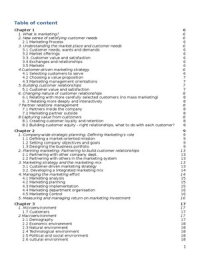Anders Henriksen – International Law
Chapter 1: Foundations and structure of international law
1.1 Introduction
International law = the system of law that regulates the interrelationship of sovereign states
and their rights and duties to one another, but to that must be added a host of other actors,
most notably international organizations and individuals who also possess rights/obligations
under international law.
1.2 A brief history of international law
1.2.1 Early modern international law
Cultures and communities traded and interacted creation of formal practices and mutual
expectations for international law.
Europe Late Middle Ages (15th and 16th century) multiple levels of different allegiances and
rights and obligations as well as the universal political and religious forces of the Holy Roman
Empire and the Catholic Church. Network of knights and merchants were transnational and
the populations often felt a closer sense of allegiance to such communities than to their
fellow nationals. World was then dominated by theories of natural law, originally developed
in the classical eras.
Natural law/jus naturale = all-embracing set of ideas about natural and social life in the
universe and, though primarily focused on the individual and his or her relations to the
world, it also applied to states by virtue of the fact that rulers were also individuals and
therefore subject to it.
Jus gentium = a law of people/nations ad hence inferior to natural law, at times simply
perceived as being derived from the latter.
Creation of legal obligations and contracts.
Also the period of the dawn of colonialism and the early confrontation between Spanish
explorers and native Indian populations and kingdoms in the New World posed a particular
challenge to the philosophers and legal scholars of the time.
It is, however, not until the 17th and 18th centuries, that we begin to see the contours of a
modern international legal system. There was a much clearer distinction between jus
naturale and jus gentium and it is from the Katter that international law as we know
subsequently develops.
1.2.2 Peace of Westphalia
Birth of the international state system. The 1648 Peace of Westphalia Peace of Munster
and the Treaties of Munster and Osnabruck. The major European powers sought to
establish a semblance of order and structure in an otherwise anarchical and disorderly
European world. Idea reduce powers of transnational forces, like empire and religion &
compartmentalize territory and individuals into sovereign states.
1.2.3 The 19th century and the era of positivism
19th century full-on assault on the idea that acts of states could be judged according to
transcendent ideals of fairness or divine will. Era of positivism the primary tenet of which
was that the only true source of law was state will.
Consensual theory unless a state has consented to be bound by a rule, no international
legal obligation exists and the state remains entitled to act as it pleases.
,Unlike natural law, positive law does not envisage a universal legal system, but rather one
that is fragmented and in which states are bound by different legal obligations.
Positivism & consensual theory fundamental influences on the theory of international
legal sources.
1.2.4 The interwar period
1919 League of Nations organization tasked with maintaining world peace. League did not
prohibit war, but it required states to submit potential destabilizing disputes to one of a
number of settlement mechanisms and to desist from resorting to war until a certain period
had elapsed following the decision by that mechanism.
1928 Treaty of Paris obligated parties to refrain from going to war as a means of settling
their international controversies and as an instrument of national policy.
Permanent Court of International Justice (PCIJ) forerunner to ICJ.
1.2.5 The period after the Second World War
Top German officials for international crimes before a war crimes tribunal in Nuremberg
important precedent in international criminal law. League of Nations was replaced by the UN
Westphalia principles, respect for the principle of equal rights and self-determination of
peoples and on the sovereign equality of all its member states.
UN Charter ban on the use of force and gave a collective organ – the Security Council –
the competence to maintain international peace and security, and if necessary, to authorize
forceful measures.
General Assembly all member states are represented. Consultative role, but it also offers
an organizational structure where all states can voice their opinions and raise their concerns.
- ICJ replaced the PCJJ.
A lot of new organizations.
1.2.6 The present
Post-Second WW developments in international law were driven by the west created a
rules-based international order less prone to the sort of economic protectionism and
authoritarianism that led the world into the chaos and mass slaughter of the SWW.
Western values notably open and free economic markets, increasing respect for individual
rights and institutional cooperation.
Western-driven ‘liberal international legal order’ under stress non-Western powers such
as China and the BRICS-countries have set up financial institutions that rival the traditional
global institutions, such as the IMF and the World Bank.
Furthermore, major Western states have experienced a revival of nationalism and a popular
‘backlash’ against some of the values and institutions that underpin the post-SWW liberal
international legal order.
1.3 The structures of international law
1.3.1 Introduction – a society of sovereign nation states
International legal system consists of two different structures of rules.
1648 Peace of Westphalia center has been the sovereign state, and international society is
first and foremost a society of individual national states.
,International law is best conceived of from the standpoint of national law and as a response
to a lawyer’s need for legal rules and principles to complement those found in national legal
systems. Whenever a lawyer encounters an issue of interest to more than one sovereign
state, it is in national law the legal answer is found.
Scope determined by the inadequacy of national law.
Content must be found in international law.
There are two ways in which an issue becomes of interest to more than one state and they
define the two substantive structures of international law:
1. The first is when two or more states may have colliding interests in the substance of
the issue. The mere fact that international society is composed of a multitude of
sovereign states with different interests is sufficient to make the issue international.
2. The second way is when the involved states have agreed in a treaty to turn the issue
into one of an international character. A matter may become an issue for
international law either due to its content or due to its form. The content is governed
by what is called ‘the international law of coexistence’ and the form is dealt with
under ‘the international law of cooperation’.
1.3.2 The international law of coexistence
The international law of coexistence/general international law contains the legal answers
to questions that are inherently of interest to more than one state and required to separate
the powers of the sovereign states and thereby uphold peaceful coexistence.
Thus, the lawyers finds the classic topics of international law where states may have colliding
interests. The fundamental principles of treaty law and the legal principles on state
responsibility are also included.
As a legal structure, the international law of coexistence is primarily horizontal in the sense
that it is mainly concerned with the manner in which sovereign states interact with and
between each other.
The international law of coexistence is similarly not concerned with binding states closer
together in some sort of international community.
Relatively stable and not subject to much change.
1.3.3 The international law of cooperation
This is where one finds the legal answers to issues not inherently of interest to two or more
states but which have been made international through the adoption of a treaty.
Issues international character, because treaties international agreements, governed by
international law.
International law of cooperation is much younger than international law of coexistence.
International law of cooperation is optional in that states are free to turn to a matter
previously dealt with by national law into a matter of international law.
1.4 The basis of international obligations
To uphold the binding character of international law seems to imply the negation of
sovereignty. It would therefore appear that either the state is sovereign, and hence not
bound by international law, or it is bound by international law, and thus not sovereign.
However, there is not an irreconcilable tension between sovereignty and international legal
obligations.
, 1.5 The relationship between international law and national law
International law asserts its own supremacy over national law.
Concern of how international law is applied in national legal systems by the legislator
and national courts. Two different approaches.
Monism national and international law essentially form a single legal order or a set
of mutually intertwined legal orders presumed to be coherent. International law can
be applied directly in the national system of states and the international norm
prevails in case of a conflict. Hans Kelsen Grundnorm.
Dualism national and international law are two separate legal systems that
operate independently. International law regulates relationship between states and
national regulates relationship between citizens en the state. International law needs
to be translated into the national legal system, through adoption of national
legislation.
Pluralism.
1.6 The issue of enforcement of international law
One of the ways the international legal system differs from a national legal setting is the lack
of a police force and a mandatory judicial system. There is, however, significant progress
when it comes to complaint mechanisms ICJ, PCA, ITLOS, ICC, DSB.
The picture is less promising when it comes to ‘policing’ and actual enforcement of breaches
of international law. Enforcement of international law remains a challenge but it is not
totally absent. In addition, non-legal incentives often move state towards compliance with
their international obligation.
1.7 The alleged inadequacy of international law in the 21st century
It is a recurring criticism of international law that its state-centric configuration is outdated
and at times counterproductive to creating a more fair and just world example; respect
for state sovereignty sometimes stands in the way of benevolent efforts to alleviate the
suffering of a distressed civilian population.
While it sounds harsh, it is a misconception to assume that the primary purpose of
international law is to create a more just world. International law often prioritizes stability
and order.
Chapter 2: Sources of international law
2.2 Article 38 of the Statue of the International Court of Justice
List of sources of international law:
1. The Court, whose function is to decide in accordance with international law such
disputes as are submitted to it, shall apply:
a. International conventions, whether general or particular, establishing rules
expressly recognized by the contesting states;
b. International custom, as evidence of a general practice accepted as law;
c. The general principles of law recognized by civilized nations;
d. Subject to the provision of Article 59, judicial decisions and the teachings of
the most highly qualified publicists of the various nations, as subsidiary means
for the determination of rules of law.
2. This provision shall not prejudice the power of the Court to decide a case e aequo et
bono, if the parties agree thereto.
Chapter 1: Foundations and structure of international law
1.1 Introduction
International law = the system of law that regulates the interrelationship of sovereign states
and their rights and duties to one another, but to that must be added a host of other actors,
most notably international organizations and individuals who also possess rights/obligations
under international law.
1.2 A brief history of international law
1.2.1 Early modern international law
Cultures and communities traded and interacted creation of formal practices and mutual
expectations for international law.
Europe Late Middle Ages (15th and 16th century) multiple levels of different allegiances and
rights and obligations as well as the universal political and religious forces of the Holy Roman
Empire and the Catholic Church. Network of knights and merchants were transnational and
the populations often felt a closer sense of allegiance to such communities than to their
fellow nationals. World was then dominated by theories of natural law, originally developed
in the classical eras.
Natural law/jus naturale = all-embracing set of ideas about natural and social life in the
universe and, though primarily focused on the individual and his or her relations to the
world, it also applied to states by virtue of the fact that rulers were also individuals and
therefore subject to it.
Jus gentium = a law of people/nations ad hence inferior to natural law, at times simply
perceived as being derived from the latter.
Creation of legal obligations and contracts.
Also the period of the dawn of colonialism and the early confrontation between Spanish
explorers and native Indian populations and kingdoms in the New World posed a particular
challenge to the philosophers and legal scholars of the time.
It is, however, not until the 17th and 18th centuries, that we begin to see the contours of a
modern international legal system. There was a much clearer distinction between jus
naturale and jus gentium and it is from the Katter that international law as we know
subsequently develops.
1.2.2 Peace of Westphalia
Birth of the international state system. The 1648 Peace of Westphalia Peace of Munster
and the Treaties of Munster and Osnabruck. The major European powers sought to
establish a semblance of order and structure in an otherwise anarchical and disorderly
European world. Idea reduce powers of transnational forces, like empire and religion &
compartmentalize territory and individuals into sovereign states.
1.2.3 The 19th century and the era of positivism
19th century full-on assault on the idea that acts of states could be judged according to
transcendent ideals of fairness or divine will. Era of positivism the primary tenet of which
was that the only true source of law was state will.
Consensual theory unless a state has consented to be bound by a rule, no international
legal obligation exists and the state remains entitled to act as it pleases.
,Unlike natural law, positive law does not envisage a universal legal system, but rather one
that is fragmented and in which states are bound by different legal obligations.
Positivism & consensual theory fundamental influences on the theory of international
legal sources.
1.2.4 The interwar period
1919 League of Nations organization tasked with maintaining world peace. League did not
prohibit war, but it required states to submit potential destabilizing disputes to one of a
number of settlement mechanisms and to desist from resorting to war until a certain period
had elapsed following the decision by that mechanism.
1928 Treaty of Paris obligated parties to refrain from going to war as a means of settling
their international controversies and as an instrument of national policy.
Permanent Court of International Justice (PCIJ) forerunner to ICJ.
1.2.5 The period after the Second World War
Top German officials for international crimes before a war crimes tribunal in Nuremberg
important precedent in international criminal law. League of Nations was replaced by the UN
Westphalia principles, respect for the principle of equal rights and self-determination of
peoples and on the sovereign equality of all its member states.
UN Charter ban on the use of force and gave a collective organ – the Security Council –
the competence to maintain international peace and security, and if necessary, to authorize
forceful measures.
General Assembly all member states are represented. Consultative role, but it also offers
an organizational structure where all states can voice their opinions and raise their concerns.
- ICJ replaced the PCJJ.
A lot of new organizations.
1.2.6 The present
Post-Second WW developments in international law were driven by the west created a
rules-based international order less prone to the sort of economic protectionism and
authoritarianism that led the world into the chaos and mass slaughter of the SWW.
Western values notably open and free economic markets, increasing respect for individual
rights and institutional cooperation.
Western-driven ‘liberal international legal order’ under stress non-Western powers such
as China and the BRICS-countries have set up financial institutions that rival the traditional
global institutions, such as the IMF and the World Bank.
Furthermore, major Western states have experienced a revival of nationalism and a popular
‘backlash’ against some of the values and institutions that underpin the post-SWW liberal
international legal order.
1.3 The structures of international law
1.3.1 Introduction – a society of sovereign nation states
International legal system consists of two different structures of rules.
1648 Peace of Westphalia center has been the sovereign state, and international society is
first and foremost a society of individual national states.
,International law is best conceived of from the standpoint of national law and as a response
to a lawyer’s need for legal rules and principles to complement those found in national legal
systems. Whenever a lawyer encounters an issue of interest to more than one sovereign
state, it is in national law the legal answer is found.
Scope determined by the inadequacy of national law.
Content must be found in international law.
There are two ways in which an issue becomes of interest to more than one state and they
define the two substantive structures of international law:
1. The first is when two or more states may have colliding interests in the substance of
the issue. The mere fact that international society is composed of a multitude of
sovereign states with different interests is sufficient to make the issue international.
2. The second way is when the involved states have agreed in a treaty to turn the issue
into one of an international character. A matter may become an issue for
international law either due to its content or due to its form. The content is governed
by what is called ‘the international law of coexistence’ and the form is dealt with
under ‘the international law of cooperation’.
1.3.2 The international law of coexistence
The international law of coexistence/general international law contains the legal answers
to questions that are inherently of interest to more than one state and required to separate
the powers of the sovereign states and thereby uphold peaceful coexistence.
Thus, the lawyers finds the classic topics of international law where states may have colliding
interests. The fundamental principles of treaty law and the legal principles on state
responsibility are also included.
As a legal structure, the international law of coexistence is primarily horizontal in the sense
that it is mainly concerned with the manner in which sovereign states interact with and
between each other.
The international law of coexistence is similarly not concerned with binding states closer
together in some sort of international community.
Relatively stable and not subject to much change.
1.3.3 The international law of cooperation
This is where one finds the legal answers to issues not inherently of interest to two or more
states but which have been made international through the adoption of a treaty.
Issues international character, because treaties international agreements, governed by
international law.
International law of cooperation is much younger than international law of coexistence.
International law of cooperation is optional in that states are free to turn to a matter
previously dealt with by national law into a matter of international law.
1.4 The basis of international obligations
To uphold the binding character of international law seems to imply the negation of
sovereignty. It would therefore appear that either the state is sovereign, and hence not
bound by international law, or it is bound by international law, and thus not sovereign.
However, there is not an irreconcilable tension between sovereignty and international legal
obligations.
, 1.5 The relationship between international law and national law
International law asserts its own supremacy over national law.
Concern of how international law is applied in national legal systems by the legislator
and national courts. Two different approaches.
Monism national and international law essentially form a single legal order or a set
of mutually intertwined legal orders presumed to be coherent. International law can
be applied directly in the national system of states and the international norm
prevails in case of a conflict. Hans Kelsen Grundnorm.
Dualism national and international law are two separate legal systems that
operate independently. International law regulates relationship between states and
national regulates relationship between citizens en the state. International law needs
to be translated into the national legal system, through adoption of national
legislation.
Pluralism.
1.6 The issue of enforcement of international law
One of the ways the international legal system differs from a national legal setting is the lack
of a police force and a mandatory judicial system. There is, however, significant progress
when it comes to complaint mechanisms ICJ, PCA, ITLOS, ICC, DSB.
The picture is less promising when it comes to ‘policing’ and actual enforcement of breaches
of international law. Enforcement of international law remains a challenge but it is not
totally absent. In addition, non-legal incentives often move state towards compliance with
their international obligation.
1.7 The alleged inadequacy of international law in the 21st century
It is a recurring criticism of international law that its state-centric configuration is outdated
and at times counterproductive to creating a more fair and just world example; respect
for state sovereignty sometimes stands in the way of benevolent efforts to alleviate the
suffering of a distressed civilian population.
While it sounds harsh, it is a misconception to assume that the primary purpose of
international law is to create a more just world. International law often prioritizes stability
and order.
Chapter 2: Sources of international law
2.2 Article 38 of the Statue of the International Court of Justice
List of sources of international law:
1. The Court, whose function is to decide in accordance with international law such
disputes as are submitted to it, shall apply:
a. International conventions, whether general or particular, establishing rules
expressly recognized by the contesting states;
b. International custom, as evidence of a general practice accepted as law;
c. The general principles of law recognized by civilized nations;
d. Subject to the provision of Article 59, judicial decisions and the teachings of
the most highly qualified publicists of the various nations, as subsidiary means
for the determination of rules of law.
2. This provision shall not prejudice the power of the Court to decide a case e aequo et
bono, if the parties agree thereto.











